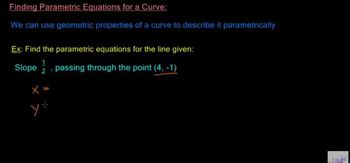Table of contents
- 0. Review of College Algebra4h 43m
- 1. Measuring Angles39m
- 2. Trigonometric Functions on Right Triangles2h 5m
- 3. Unit Circle1h 19m
- 4. Graphing Trigonometric Functions1h 19m
- 5. Inverse Trigonometric Functions and Basic Trigonometric Equations1h 41m
- 6. Trigonometric Identities and More Equations2h 34m
- 7. Non-Right Triangles1h 38m
- 8. Vectors2h 25m
- 9. Polar Equations2h 5m
- 10. Parametric Equations1h 6m
- 11. Graphing Complex Numbers1h 7m
10. Parametric Equations
Writing Parametric Equations
Problem 5.51
Textbook Question
Textbook QuestionIn Exercises 45–52, use your answers from Exercises 41–44 and the parametric equations given in Exercises 41–44 to find a set of parametric equations for the conic section or the line.
Line: Passes through (−2,4) and (1,7)
 Verified Solution
Verified SolutionThis video solution was recommended by our tutors as helpful for the problem above
Video duration:
3mPlay a video:
Was this helpful?
Key Concepts
Here are the essential concepts you must grasp in order to answer the question correctly.
Parametric Equations
Parametric equations express the coordinates of points on a curve as functions of a variable, often denoted as 't'. For a line, these equations can be derived from two points by defining 't' as a parameter that varies between the two points, allowing for the representation of the line segment in a more flexible way.
Recommended video:

Parameterizing Equations
Slope of a Line
The slope of a line is a measure of its steepness, calculated as the change in the y-coordinates divided by the change in the x-coordinates between two points. For the points (−2, 4) and (1, 7), the slope can be found using the formula (y2 - y1) / (x2 - x1), which is essential for forming the parametric equations of the line.
Recommended video:

Verifying Equations as Functions
Vector Representation
Vector representation involves using a position vector to describe the direction and magnitude of a line. By taking one of the points as a starting point and adding a scaled direction vector (derived from the slope), we can create parametric equations that represent the line in a concise form, facilitating easier calculations and visualizations.
Recommended video:

Introduction to Vectors

 8:02m
8:02mWatch next
Master Parameterizing Equations with a bite sized video explanation from Patrick Ford
Start learningRelated Videos
Related Practice








